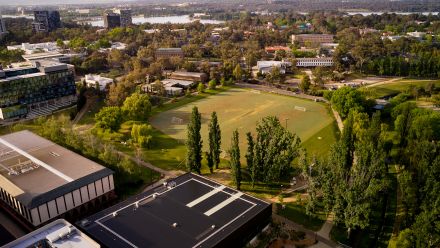Desert journeys on display at the Class of 2022’s Grad Show
An incredible family heritage and epic treks across Australia on camels are some of the powerful themes explored in the School of Art and Design graduation exhibition now on display at The Australian National University (ANU).
This year's exhibition, which celebrates the class of 2022, also explores themes of healing, environment and social change, connection and identity.
Among the works of the 57 graduating students is an interactive game allowing players to write their own rules, a canvas tent inspired by Australia's cameleers, sculptures made in memory of queer lives lost to hate crimes and suicide and bicycle wheels woven with denim.
The compelling works cover a range of mediums, including glass, ceramics, textiles, sculpture, photomedia, printmedia, drawing and painting. There's also AI, video and sound installations on show.
Head of School, Associate Professor Beck Davis, said the exhibition marks "a tremendous achievement", despite the challenges of the past few years.
"Our student body is diverse and talented, and the work shared illustrates a dynamic and creative range," Associate Professor Davis said.
"Our graduates join the celebrated ranks of ANU alumni with their names joining an exceptional list of professional artists, art historians, curators and designers."
Gabriela Renee is among the graduating students exhibiting their works. Her artwork, Balik Kampung, Going Home... is an immersive exploration of her cultural heritage.
She was inspired to investigate her cultural identity and family history through her art after a university field trip to Tumut on Wiradjuri, Wolgalu and Ngunnawal country.
"After listening to all the First Nations people speak about their connection to land and place and how closely this was tied to their identity and community, I felt quite disheartened realising I didn't have that sense of belonging," Ms Renee said.
"I felt disconnected from my culture and my ethnicity and what it means even to be of mixed race."
This experience inspired a deep dive of her family history, speaking to relatives, learning about old stories and looking through old photographs.
"Ethnically, I am of Sinhalese, Malayali, English, Shetlander, German and Irish decent," Ms Renee said.
"As an Australian Malaysian, the journey of uncovering this hybridity has been a deeply personal investigation of images, objects and materials."
Through a colourful installation of draped fabric, Ms Renee's family history is layered within textiles "that evoke the clothing made and worn by her ancestors around the world." This includes embroidered saris, handmade lace and tartan.
Gathered from family archives, Ms Renee has layered photos of her ancestors into the work.
"Embedding and layering these images within textiles that evoke the clothing made and worn by my ancestors around the world, I navigate a complex set of histories and challenge the documentary purpose of photography," she said.
The work embraces the viewer and at the same time asks them "to question what it means to be of mixed race and embrace the complex identities that are formed from different cultures and ethnicities."
Tash Barber is another student whose work is being displayed at the exhibition.
Her work, Mapping Before Erasure: The Outback Cameleers explores the journeys undertaken by the cameleers in the Australian outback during the 1860s to 1930s, who predominantly came from Pakistan, northern India, Afghanistan and Iran.
Ms Barber constructed a large textile tent installation from cotton and canvas which viewers are invited to explore.
"The cameleers were responsible for the development of nearly every non-coastal settlement in Australia. They provided towns with essential goods, leisure activities, and supported the construction of Australia's telegraph system," she said.
"But these contributions really aren't recognised. It's not part of the school curriculum, there's very little information available online and many of the mosques and cultural sites built by these communities have been destroyed from lack of preservation.
"I wanted to create something that would envelope people in the stories of the cameleers.
"The exterior of the tent maps the vast journeys taken by the cameleers and marks significant mosques and cemeteries. And when you walk into the tent you are surrounded by drawings of the cameleers, and their camels."
Ms Barber used archival photographs as inspirations for her drawings, some of which were provided by descendants of the cameleers who she met during a research trip to Broken Hill for the project.
The 2022 ANU School of Art and Design graduation exhibition runs daily between 10am and 4pm from Saturday 26 November until Sunday 4 December. The public opening takes place on Friday 25 November from 6 to 8pm.
The works of honours and master's students will be displayed in the main gallery, with the works of all other undergraduates on display in the School's studios.


